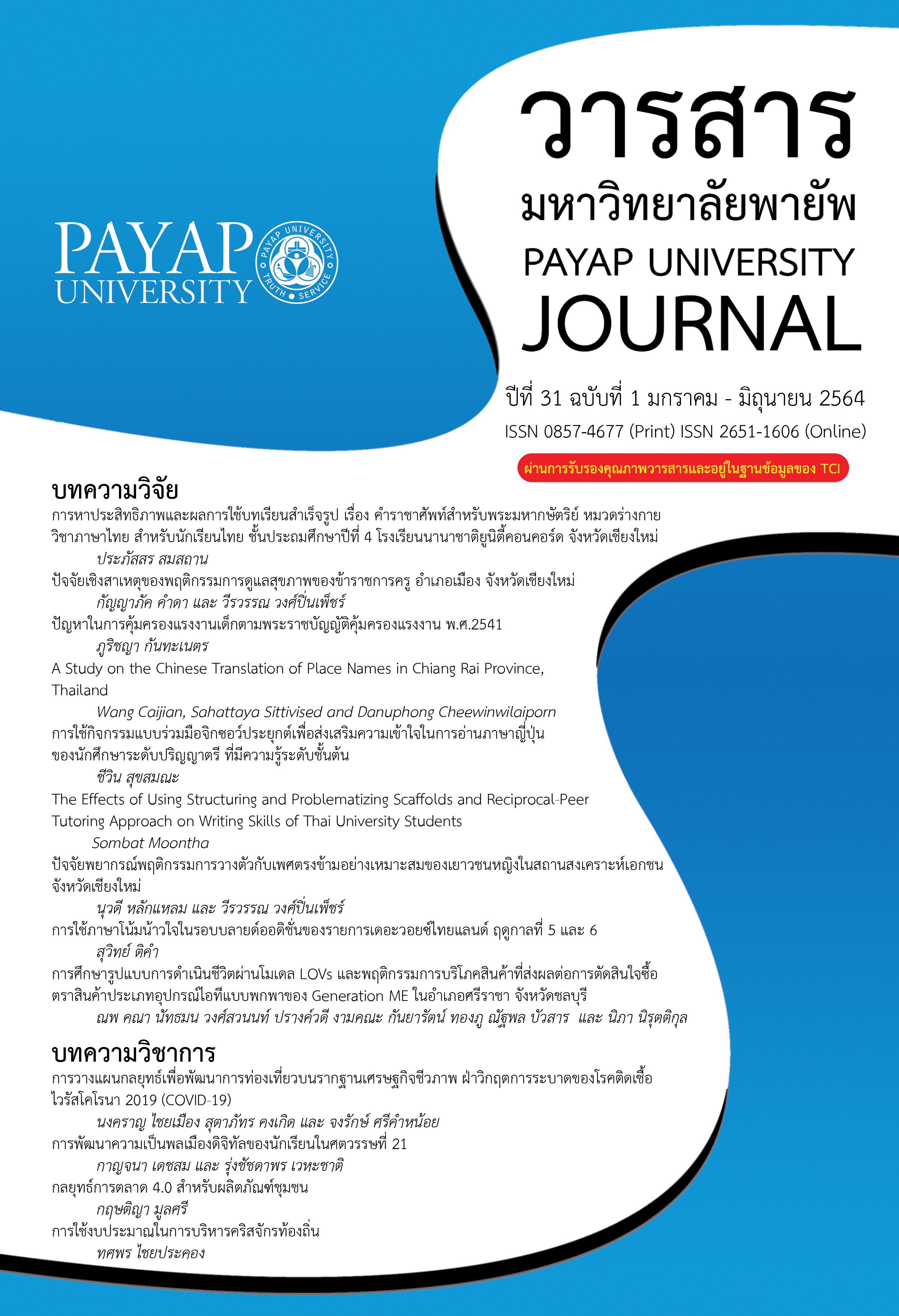The Use of Apply-Jigsaw Cooperative Learning Activity to Support Japanese Reading Comprehension of Undergraduate Students with Fundamental Knowledge
Main Article Content
Abstract
The purpose of this research was to study the students’ Japanese reading comprehension before and after learning through apply-jigsaw cooperative learning activity. The participants were sixteen undergraduate students who registered for the course Japanese 3 in the first semester of the academic year 2020 at Payap University. The research instruments consisted of four lesson plans using apply-jigsaw cooperative learning activity and Japanese reading comprehension test. The Japanese reading comprehension test was administered before and after apply-jigsaw cooperative learning activity. Descriptive statistic of mean and standard deviation was performed for data analysis. The finding of this study revealed that the students’ Japanese reading comprehension was improved after learning through apply-jigsaw cooperative learning activity with average scores of 13.75 and 18.75, before and after the activity, respectively.
Article Details
References
นพเก้า ณ พัทลุง. (2558). การประเมินหลักสูตร: มิติที่สำคัญในการพัฒนาหลักสูตร. วารสารการศึกษา กทม, 6(11), 25-36.
ทิศนา แขมมณี. (2554). ศาสตร์การสอนองค์ความรู้เพื่อการจัดกระบวนการเรียนรู้ที่มีประสิทธิภาพ 2. กรุงเทพฯ: จุฬาลงกรณ์มหาวิทยาลัย.
ผกาศรี เย็นบุตร. (2542). เอกสารประกอบการสอนวิชา ท.0211 (การอ่าน). กรุงเทพฯ: คณะมนุษยศาสตร์ มหาวิทยาลัยศรีนครินทรวิโรฒ.
วงศ์ปกรณ์ พชรธรรมโรจน์. (2551) ผลการเรียนแบบร่วมมือแบบจิกซอว์โดยใช้บล็อกที่มีต่อผลสัมฤทธิ์ทางการเรียนภาษาฝรั่งเศสของนักเรียนชั้นมัธยมศึกษาปีที่ 5. วิทยานิพนธ์ปริญญามหาบัณฑิต คณะครุศาสตร์ จุฬาลงกรณ์มหาวิทยาลัย.
สงวน เกตุปรางค์. (2553). การพัฒนาความสามารถด้านการอ่านเพื่อความเข้าใจของนักเรียนชั้นมัธยมศึกษาปีที่ 1 ด้วยกระบวนการร่วมมือกับเทคนิค Jigsaw. วิทยานิพนธ์ปริญญามหาบัณฑิต คณะศึกษาศาสตร์ มหาวิทยาลัยขอนแก่น.
สำนักวิชาคณะกรรมการการศึกษาขั้นพื้นฐานกระทรวงศึกษาธิการ. (2551). แนวทางการจัดการเรียนรู้ตามหลักสูตรแกนกลางการศึกษาขั้นพื้นฐานพุทธศักราช 2551. กรุงเทพฯ: ผู้แต่ง.
สุวคนธ์ ทองแม้น. (2547). การพัฒนาทักษะการอ่านจับใจความด้วยเทคนิคจิกซอว์ (Jigsaw) กลุ่มสาระการเรียนรู้ภาษาไทย ชั้นมัธยมศึกษาปีที่ 1. วิทยานิพนธ์ปริญญามหาบัณฑิต คณะศึกษาศาสตร์ มหาวิทยาลัยมหาสารคาม.
Bournemouth University. (2002). Peer assisted learning, Retrieved June 17, 2020. http://www. peerlearning .ac.uk/htm/all about.pal.html
Fuchs, L. S., & Fuchs, D. (1998). Treatment validity: A unifying concept for conceptualizing the identification of learning disabilities. Learning disabilities Research and Practice, 13(4), 204-219.
Iijima, Y. (2012). ピア・リーディングによるノートテイキングの試みー「日本事情」クラスにおけるドキュメンタリー映像視聴の記憶として」(Using peer reading skill for note-taking: Though the note-taking activities of documentary movies in ‘current issue in Japan’). Master’s thesis. Kansai University of International Studies.
Johnson, D. W. & Johnson, R. T. (1991). Learning together and alone. Englewood Cliffs, NJ: Prentice-Hall.
Tateoka, Y. (2006). Hitoride yomu koto kara pia riiingu e nihongo gakushuusha no dokkai katei to taiwa teki kyoudou gakushuu (Japanese learning from reading alone to ‘Peer reading’: reading process of Japanese language learners and collaborative learning through dialogue). Tokyo: Tokai University.


